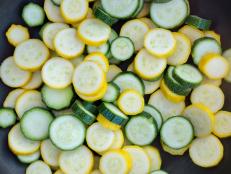How to Freshen Stale Bread in 3 Easy Steps
Revive less-than-fresh loaves with this cool trick.

Yulia Naumenko / Getty Images
By Regan Cafiso for Food Network Kitchen
Fresh, crusty bread is one of life's greatest pleasures. But its shelf-life is fleeting. Even when stored properly, bakery-style loaves like peasant bread, sourdough and baguettes last only a few days at room temperature before going stale and rock-hard. But we've got a fix. If your loaf hardens, follow these simple steps to make it as good as new.
Why Does Bread Go Stale?
Bread gets hard and stale when it dries out, but there's a little more to it than that — a loaf can go stale even in humid conditions. So what gives? "Staling" is a natural process that occurs when the water and starch molecules that were made spongy during baking begin to rearrange themselves once the bread has cooled. The water moves out of the loaf's interior, migrating towards the crust and eventually into the air. The starches re-harden and then, poof! Rock-hard bread. Colder temperatures hasten this process, which is why you should never store bread in the fridge. (Freezing, however, is another story — we'll get to that later!)
How to Revive Stale Bread
Of course there are plenty of delicious things to make with a loaf of stale bread: French toast, croutons, breadcrumbs and bread pudding are just a few of them. But sometimes you just want a nice slice. We polled our culinary staffers and they overwhelmingly chose this method to restore bread to its original soft, crusty glory.
- Begin by heating the oven to 300 degrees F. (A lower temperature allows you to rehydrate the loaf slowly instead of drying it further.)
- Take your whole loaf or partial loaf and run it quickly under running water just to wet the outside. If it has been cut, turn the cut-end downward to avoid saturating the interior (but don't worry if it gets a little wet inside).
- Place the loaf on a baking sheet and heat until it is dry and crusty on the outside — 6 to 10 minutes, depending on its size and wetness.
Keep in mind that this method is intended for whole and partial loaves — not for ones pre-cut into slices. If the bread is pre-sliced, you're better off making a recipe that uses stale bread. If the bread is moldy, it cannot be saved and should be thrown away.
Preventing Staleness in the First Place
All bread will eventually go stale, but this sad fate can be slowed or halted with proper storage. If you plan to eat your bread within a few days, be sure to wrap it tightly in plastic wrap and store it at room temperature. If you have extra loaves that you'd like to make last, freeze them. Wrap each tightly in two layers of plastic wrap, seal in a freezer bag and stash in the freezer for up to 3 months.
Our Favorite Bread Recipes:
Related Links:































































